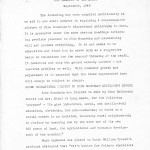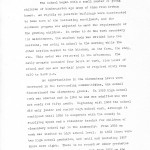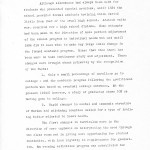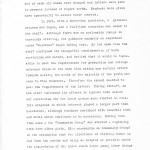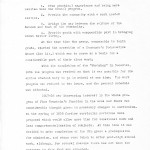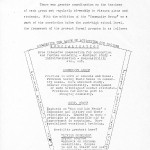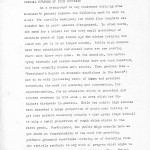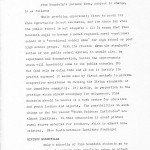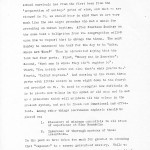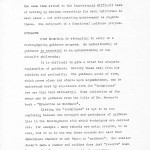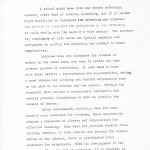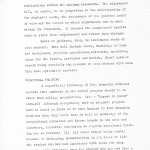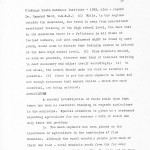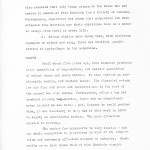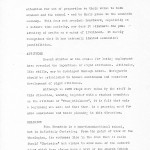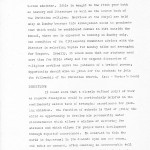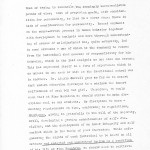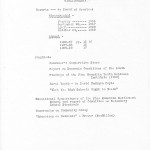Pine Mountain Settlement School
Series 01: HISTORIES
Series 04: ADMINISTRATION — Directors
Series 13: EDUCATION
Glyn Morris
1940 General Statement of History
and Philosophy of PMSS for Staff
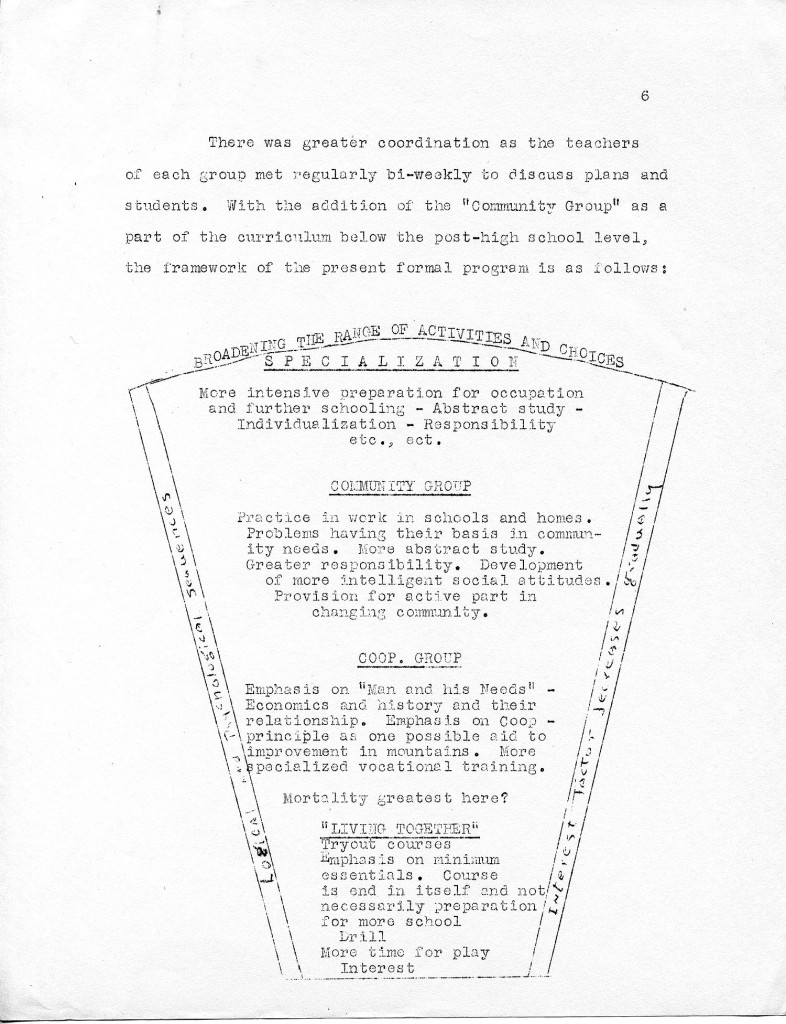
General Statement of History and Philosophy of PMSS for members of Staff, p.6. [gen_history_pmss_1940_006.jpg]
TAGS: Glyn Morris, directors, Pine Mountain Settlement School, Harlan County, Kentucky, philosophy, beliefs. religion, education, progressive education
GLYN MORRIS 1940 General Statement of History and Philosophy of PMSS for Staff
This not-so-brief eighteen-page document was produced by Glyn Morris in 1940, just two years short of his departure from the School. It was developed to meet the need for a general statement of purpose based on the history and philosophy of the school from his perspective. The document was intended for members of the existing and in-coming staff. When reviewed against earlier administrative documents created within the decade before Morris, the emergence of a new institutional philosophy may be seen.
Glyn Morris brought to the school a palpable encounter with the world outside the narrow valley of Pine Mountain. Young, but world-wise, Morris introduced a strain of Progressive Education that attempted to integrated the most current views on education, agriculture, economics, and religion. His preparation was at Union Theological Seminary where he studied under such progressive luminaries as the Christian Realist and pragmatic theologian, Reinhold Niebuhr. He was also strongly influenced by the work of the leading progressive educator, John Dewey, Morris worked hard to shift the school and its growing body of young adults to the contemporary world of work and civic responsibility. He championed the development of the individual while insisting on a community consciousness. His institution of a “guidance program” in 1935 brought Morris and the school national recognition. The historic programs at the school were adjusted to a formalized work, service and learning regimen. Accommodations were made in the curriculum for a “Community Group” a cohort of students who were charged to:
(1.) Give practical experience and bring more realism into the school program.
(2.) Provide the community with a much-needed service,
(3.) Bridge the gap between the culture of the School and that of the community,
(4.) Provide youth with [a] responsible part in bringing about better living.
He then proposed a revised Pine Mountain’s purpose, which he noted was “subject to change.” This purpose was to include a “thoroughgoing guidance program, vocational training, an agricultural program, work with crafts, and “right attitudes” within the students at the School. He also carefully spelled out rules and guidelines for behavior and the institution’s non-denominational stance with regard to its religious teaching.
1946 ARTHUR DODD REVISION OF THE MORRIS DOCUMENT
The Morris 1940 “Statement of History and Philosophy of Pine Mountain Settlement School” was revised in 1946 by then-Principal at the School, Arthur W. Dodd. When compared to the earlier Glyn Morris document of 1940, the Arthur Dodd revision of the “General Statement of History and Philosophy of Pine Mountain Settlement School, Revised (1946), is a remarkable window into the changes in administration and subtle shifts in the administrator’s perceptions of the mission of the School. Rather than expansion, Dodd narrowed and reduced the statement to thirteen pages and tightened the program requirements for student behavior. While Dodd reduced the document in size, his changes were broad in scope when inspected carefully against the original Morris document.
See Also:
ARTHUR W. DODD 1946 General Statement of
History and Philosophy of PMSS for Staff
GALLERY
- General Statement of History and Philosophy of PMSS for members of Staff gen_history_pmss_1940_001.jpg
- General Statement of History and Philosophy of PMSS for members of Staff gen_history_pmss_1940_002.jpg
- General Statement of History and Philosophy of PMSS for members of Staff gen_history_pmss_1940_003.jpg
- General Statement of History and Philosophy of PMSS for members of Staff gen_history_pmss_1940_004.jpg
- General Statement of History and Philosophy of PMSS for members of Staff gen_history_pmss_1940_005.jpg
- General Statement of History and Philosophy of PMSS for members of Staff gen_history_pmss_1940_006.jpg
- General Statement of History and Philosophy of PMSS for members of Staff gen_history_pmss_1940_007.jpg
- General Statement of History and Philosophy of PMSS for members of Staff gen_history_pmss_1940_008.jpg
- General Statement of History and Philosophy of PMSS for members of Staff gen_history_pmss_1940_009.jpg
- General Statement of History and Philosophy of PMSS for members of Staff gen_history_pmss_1940_011.jpg
- General Statement of History and Philosophy of PMSS for members of Staff gen_history_pmss_1940_012.jpg
- General Statement of History and Philosophy of PMSS for members of Staff gen_history_pmss_1940_012.jpg
- General Statement of History and Philosophy of PMSS for members of Staff gen_history_pmss_1940_013.jpg
- General Statement of History and Philosophy of PMSS for members of Staff gen_history_pmss_1940_014.jpg
- General Statement of History and Philosophy of PMSS for members of Staff gen_history_pmss_1940_015.jpg
- General Statement of History and Philosophy of PMSS for members of Staff gen_history_pmss_1940_016.jpg
- General Statement of History and Philosophy of PMSS for members of Staff gen_history_pmss_1940_017.jpg
- General Statement of History and Philosophy of PMSS for members of Staff gen_history_pmss_1940_018.jpg
TRANSCRIPTION: GLYN MORRIS 1940 General Statement of History and Philosophy of PMSS for Staff
[Note: The following transcription has been slightly edited for clarity. The text in these documents, which were mimeographed copies of typewritten originals, was not always entirely legible, as indicated by a question mark or words in brackets [?].]
001
GENERAL STATEMENT OF HISTORY AND PHILOSOPHY OF PINE MOUNTAIN SETTLEMENT SCHOOL
For Members of the Staff
September, 1940
The following has been compiled particularly as an aid to new staff members in acquiring a comprehensive picture of Pine Mountain’s educational philosophy to date. It is presented under the more obvious headings reflecting problems peculiar to Pine Mountain and necessarily will not include everything. It is not meant to be exhaustive nor final but to serve only as a suggestive basis or touchstone for the [sub]sequent thinking of the staff. It indicates not only the ground already covered — but unsolved problems as well. With constant growth and adjustment it is expected that the ideas represented here will always be subject to change.
BRIEF EDUCATIONAL HISTORY OF PINE MOUNTAIN SETTLEMENT SCHOOL
Pine Mountain was founded in 1913 by Miss Katherine Pettit and Mrs. Ethel de Long Zande for the following “purpose” — “To give industrial, moral, and intellectual education, Christian, but non-sectarian; to serve as a social centre [sic] in an isolated, intensely rural neighborhood; to further by teaching and by the wise use of its own 235 acres of land, the agricultural and economic development of the country.”
Much emphasis was placed on Uncle William Creech’s profound statement that “Hit’s better for folkses characters if they larn to do things with their hands.”
002
The school began with a small number of young children of kindergarten age, many of them from broken homes. As rapidly as possible buildings were constructed to take care of the increasing enrollment, and the academic program was adjusted to meet the requirements of the growing children. In order to do the work necessary for maintenance, the student body was divided into two sections, one going to school in the morning while the other section worked in the kitchen, on the farm, the shop, etc. This order was reversed in the afternoon. The daily program included four hours of work, five hours of school and one and one-half hours of required study from 6:30 to 8:00 p.m.
As opportunities in the elementary level were increased in the surrounding communities, the school discontinued the elementary grades. In 1920 high school work was started and in 1924 no one was admitted who was not ready for fifth grade. Beginning with 1930 the school did only junior and senior high school work, although it continued until 1936 to cooperate with the county in supplying space and a volunteer teacher for children of elementary school age in the community. From 1938 on work was limited to high school level. In 1923 there were two high school graduates, and until and including 1927 there were eight. There is no record of other graduates until 1931, when there were two — but from 1932 on the graduating classes included anywhere from eight to fifteen students.
003
Although allowances had always been made for students who presented special problems, until 1934 the school provided formal academic training which varied little from that of the usual high school. Sixteen units were required for a high school diploma. Some attempts had been made in the direction of more perfect adjustment of the school program to individual needs but not until 1934 did it seem wise to make any large scale change in the formal academic program. Since that time there has been more or less continuous study and adjustment. These changes were brought about primarily by the recognition of two facts:
- Only a small percentage of enrollees go to college — and the academic program following the traditional pattern was based on eventual college entrance. At the present (1940) however, a study of graduates shows 30% as having gone to college.
- Rapid changes in social and economic structure of Harlan [County] and adjoining counties called for a type of training better adjusted to local needs.
The first changes in curriculum were in the direction of more emphasis on interpreting the area through the class room and in giving more opportunity for student initiative, with less rigidity in requirements for graduation. An evening activities program was substituted for the required study period. The usual examinations at the….
004
…end of each six weeks were dropped and letters were sent to parents instead of report cards. Students were given more opportunity to select their courses.
In 1935, with a three-day institute, a guidance program was begun, and a full-time counselor was added to the staff. Although there was no noticeable change in curricula offering, the guidance emphasis as explained under “Guidance” began taking root. At the same time the staff continued its thoughtful consideration of both curriculum and method, and decided that it would be impossible to meet the requirements for graduation and college entrance while at the same time making any serious effort towards meeting the needs of the majority of the youth who came to Pine Mountain. Therefore the school decided to meet the requirements of the latter. During 1936-37, as the staff continued its efforts to improve both method and curriculum the two lower groups were started on flexible programs in which interest played a larger part than heretofore, although teachers continued with remedial work and drill which continues to be necessary. During this time also — the “Community Group” was started — beginning with five older girls, (See memorandum on Community Group) on the assumption that the experience of visiting homes up and down the creeks and being as helpful as possible under the supervision of the nurse would serve among other things the following useful purposes:
005
- Give practical experience and bring more realism into the school program.
- Provide the community with a much needed service.
- Bridge the gap between the culture of the School and that of the community.
- Provide youth with [a] responsible part in bringing about better living.
At the same time the group, comparable to tenth grade, started the operation of a consumer’s Cooperative Store (See Lit.) which was to serve as a basis for a considerable part of their class work.
With the completion of the “Workshop” in December 1936, the program was [revised?] so that it was possible for the entire student body to go to school at one time. The work program was reduced to two hours, and the present schedule was effected.
1937-38 saw increasing interest in the whole program of Pine Mountain’s function in the area and there was considerable thought given to necessary changes in curriculum. In the spring of 1938 further curricular revisions were proposed which would allow more time for vocational work and less compartmentalization of subjects. At this time it was decided to make completion of the 8th grade a prerequisite for admission, and steps were taken to offer post-high school work, although for several reasons there has not been the response to this that was expected.
006
There was greater coordination as the teachers of each group met regularly bi-weekly to discuss plans and students. With the addition of the ”Community Group” as a part of the curriculum below the post-high school level, the framework of the present formal program is as follows:
[A rectangular graph lists the following curricula surrounded by the words “BROADENING THE RANGE OF ACTIVITIES AND CHOICES” across the top, “Logical and Psychological Sequences[?]” along the left side, and “Interest Factor Decreases[?] Gradually” along the right side.]
SPECIALIZATION
More intensive preparation for occupation and further schooling — Abstract study — Individualization — Responsibility — etc., etc.
COMMUNITY GROUP
Practice in work in schools and homes. Problems having their basis in community needs. More abstract study. Greater responsibility. Development of more intelligent social attitudes. Provision for active part in changing community.
COOP. GROUP
Emphasis on “Man and his Needs” — Economics and history and their relationship. Emphasis on Coop — principle as one possible aid to improvement in mountains. More specialized vocational training.
Mortality greatest here?
“LIVING TOGETHER”
Tryout courses. Emphasis on minimum essentials. Course is end in itself and not necessarily preparation for more school. Drill. More time for play. Interest.
007
GENERAL PURPOSE OF PINE MOUNTAIN
As a background to any statement defining Pine Mountain’s general purpose the following must be kept in mind: The specific emergency for which Pine Mountain was founded has in great measure disappeared. In other words, the need for a school for the very small percentage of mountain youth of high school age who wished training but could not get it is no longer accurate. Public high schools have been established and school buses are now serving where once there were none.
In the meantime, the underlying economic and social conditions have not been remedied, but have actually become more acute. That problem (see — President’s Report on Economic Conditions in the South”) has to do with increasing waste of human and material resources; the need for planning and cooperation, for experimentation, for an education which is practical and touches everyone in this area — an area which has the highest birth rate in America. While the public high schools have absorbed a large proportion of youth once waiting to get into private secondary schools — that group (high school) is only a small proportion of youth which starts in the first grade. Furthermore, the public high schools have as yet shown no comprehension of the need for providing Guidance grounded vocational training or of deviating from the strictly academic to any kind of program which might be useful in the area, whatever that might be. (See — “Rural Youth”, David Cushman Coyle — Also — “What the High School Ought to Teach”.)
008
Pine Mountain’s purpose then, subject to change, is as follows:
While providing opportunity first to youth for whom opportunity is not available, and for those for whom the public school is not adequate — (1) It seems that Pine Mountain ought to become a model regional rural vocational school or a “vocational school plus” for high school or post high school groups. With its freedom from the standardization of the public school system, it should also, by experiment and demonstration, hasten the improvements which will inevitably come to the public schools. (2) But (and only by doing this and [?] can it justify its present expense) it seeks also by direct methods to provide cooperative assistance in raising the living standards of the immediate community. (3) Lastly, in proportion to the prestige which should accompany its uniqueness, Pine Mountain should be useful as a work center for educators and youth leaders and experts. The possibilities in such things as the two recent “Youth Guidance Institutes” are almost limitless. In this connection it could produce rural source material for teachers, which is almost nonexistent. (See Youth Guidance Institute Findings.)
MINIMUM ESSENTIALS
Only a minority of Pine Mountain students go to college — therefore great care should be taken to adjust the training at Pine Mountain to the actual needs of EACH….
009
…student. Because the approach to construction of high school curricula has from the first been from the “preparation of college” point of view, and that we are steeped in it, we should bear in mind that we are very much like the old Negro preacher who had a mania for preaching on infant baptism. After fourteen Sundays on the same text a delegation from the congregation called upon him to request that he change the theme. The next Sunday he announced the text for the day to be “Adam, where art Thou?” Then he elaborated, saying that the text had four parts. First, “Every man is Somewhar”. Second, “Most men is where they ain’t oughter be”. Third, “You bettah watch out else that’s whar you’ll be.” Fourth, “Infant Baptism.” And passing up the first three parts with little notice he came right down to the fourth and preached on it. We need to recognize how difficult it is to create new values in the midst of old ones and to set up a procedure which will maintain all the values in the present system, and yet be fresh and functional and efficient. Among other things, continuous emphasis should be placed on:
- Discovery of minimum essentials in all areas of experience at Pine Mountain.
- Insurance of thorough mastery of these Essentials.
In the past we have taken too much for granted in assuming that “exposure” to a course guaranteed mastery. While we should seek to expand and enrich our offerings, we should at…
010
…the same time attend to the increasingly difficult task of setting up minimum essentials for each individual in each class — and safe-guarding achievement as regards these. One safeguard is a functional guidance program.
GUIDANCE
Pine Mountain is attempting to carry on a thorough-going guidance program. An understanding of guidance is essential to an understanding of the school’s philosophy.
It is difficult to give a brief but adequate explanation of guidance. Brevity takes away from its subtlety and profundity. The guidance point of view, which grows clear and simple upon acquaintance, can be understood best by experience with its “techniques” (we use this term advisedly). Some indication of its range may be gathered from the title of Dr. Brewer’s book — “Education as Guidance”.
Listing the “techniques” is apt to be too confusing because the strength and usefulness of guidance lies in the thoroughness with which techniques are carried out. For example — many schools are using records, to be sure, but it is in the way these records are used that determines whether or not there is “guidance”. One swallow doesn’t make a summer and neither does just “records” mean “guidance”. The same may be said of counseling.
011
A school might have rich and varied offerings, covering every kind of training necessary, but if it lacked right facilities to interpret its offerings and likewise the ability to interpret the youngsters to the offerings, it could easily miss the mark by a wide margin. The increasing complexity of life calls for special emphasis and safeguards in guiding and adjusting the student to these complexities.
Guidance does not eliminate the problem of method in the classroom, nor does it settle the ever present problem of curriculum. It goes hand in hand with these matters — inter-playing and supplementing, making a good balance and pointing out further adjustments both on the part of the student and the school. Through the counselor this becomes a continuously systematic and orderly process, eliminating as much as possible the element of chance.
After continuously whittling away all that doesn’t seem essential for everyone, there necessarily remains a framework of classes and organization for effective teaching. This does not preclude further flexibility, however, if both outside and through the organization of the classes, there is established other machinery for adjustment. With the development of the “individual” as the end of education, it is possible to make all kinds of reasonable adjustment and effect many….
012
combinations within the minimum framework. The adjustment will, of course, be in proportion to the understanding of the student’s needs, the acceptance of the guidance point of view, and the extent to which adjustments can be made within the framework. It becomes the counselor’s special task to start those adjustments and follow them through.
Basic to guidance, then, is continuous study of each student. This will include tests, knowledge of home and background, previous experiences, interests, anecdotes, plans for the future, aptitudes and health. Staff members should study carefully the records of each student with whom they have systematic contact.
VOCATIONAL TRAINING
A superficial follow-up of Pine Mountain students reveals that emphasis in the school program should be on other than college preparation. (See — “Report to Board” 1939-40.) Although recognizing that an adequate program must be based on facts as to what happens to Pine Mountain students when they leave here as well as knowledge of the occupational situation and future trends in the area and elsewhere, tentative conclusion as regards vocational training are as follows: (1) All other things being equal, because of increasing mechanization in all areas of life the student who has had experience with tools and shop work has some advantage over the student who has not. (See — ….
013
Findings Youth Guidance Institute — 1939; also — report Dr. Raymond Ward, U.S.E.S.) (2) While, in the regions outside the mountains, the trend is away from specialized vocational training at the high school level, the fact that in the mountains there is a deficiency in all kinds of trained workers, and that employment might be found by more youth, [it] would seem to dictate that training should be offered at the late high school level. (3) Pine Mountain should, as soon as possible, discover what kind of terminal training is most necessary and adjust itself accordingly. (4) In all areas, the school should make its work as terminal as possible. (5) There is yet too much emphasis on books and not enough assurance that manual skills, which are most essential, are being mastered.
AGRICULTURE
A cursory investigation of facts would show that there has been no realistic thinking as regards agriculture in the mountains. Special attention is given to a statement regarding agriculture for two reasons — both of which can only state the problem:
- Too much emphasis has been placed on the importance of agriculture in the curriculum at Pine Mountain. Although the rural mountain people grow much of their own food, rural mountain youth from the far away hollows are not in the majority at Pine Mountain and if they should be, it is to get away from agriculture into some more lucrative occupation. Samplings of Pine Mountain students….
014
…also revealed that only those return to the farms who are unable to remain at Pine Mountain for a variety of reasons. Furthermore, experience has shown that youngsters who have attended Pine Mountain use their experience here as a means to escape from rural to urban life.
- Recent studies have shown that, with different emphasis on method and crop, there are fruitful possibilities in agriculture in the mountains.
CRAFTS
Until about five years ago, Pine Mountain produced large quantities of bag-handles and smaller quantities of walnut trays and paper knives. It also carried on considerable weaving and student labor. The financial return for the time and labor and inconvenience to the rest of the school was very small. Furthermore, after a boy had produced so many bag-handles, there was no educational value in what he was doing — yet, because he could produce them, it was necessary to keep him at that work in order to supply an established market. The same situation applied to weaving.
The market for handcrafts is very limited — and the whole occupation is precarious in view of the competition and extremely efficient methods of industry. Handcrafts as we have known them at Pine Mountain require….
015
…attention far out of proportion to their value to both student and the school — and to their place in the mountain economy. This does not preclude handiwork, especially as a leisure time activity, nor does it eliminate the possibility of crafts as a means of livelihood. It merely recognizes that it has extremely limited economical possibilities.
ATTITUDES
Recent studies on the causes for losing employment have revealed the importance of right attitudes. Attitudes, like skills, may be developed through habit. Safeguards should be established to ensure continuous and conscious development of right attitudes.
Although in 1938 steps were taken by the staff in this direction, working together with a student committee on the attitude of “Thoughtfulness,” it is felt that only a beginning was made and that there is a pressing need for more consistent and basic planning in this direction.
RELIGION
Pine Mountain is a non-denominational school, but is definitely Christian. From the point of view of the theologian, its weakness lies in the fact that it calls itself “Christian” but wishes to show none of the outward signs which have always been a part of the church (which despite its mistakes has safeguarded the best in the Christian tradition). The Director is an ordained. Presby-….
016
…terian minister. Bible is taught in the first year both as history and literature as well as the source book of the Christian religion. Services at the Chapel are held only on Sunday because this arrangement seems to proximate that which would be considered normal in life outside the School, where one is expected to worship on Sunday only. One committee of the Citizenship Committee advises with the Director in selecting topics for Sunday talks and arranging for Vespers. Ideally, it would seem that our students need more time for Bible study and for [sub]sequent discussion of religious problems under the guidance of a trained person. Opportunity should also be given for the students to join the fellowship of the Christian Church. (See — Worker’s Book.)
DISCIPLINE
It would seem that a clearly defined point of view as regards discipline would be particularly helpful in the continuously sacred task of arranging experiences for growing children. One function of schools is that of giving the child an opportunity to develop his personality under circumstances which allows a minimum of suffering for mistakes and which allows for proper habit development through repeated experiences. In contrast to this the world is impersonal in its demands upon men and women, and takes no excuses, often exacting an unreasonable toll for mistakes. Therefore, the problem of the educator is….
017
…that of trying to reconcile two seemingly [irreconcilable] points of view; that of preparing youth, with consideration for personality, to live in a world where there is lack of consideration for personality. Recent emphasis on the cause-effect process in human behavior together with development in analysis and more thorough understanding of causes of maladjustment has, quite naturally, led to some extremes — one of which is the tendency to remove from the individual that measure of responsibility for his behavior, which in the last analysis no one else can assume. This has expressed itself in a form of experience which is as unreal in one area of life as the traditional school was in another. Dr. Alexis Carrel goes so far as to assert that modern education develops to a maximum the [innate] selfishness of each boy and girl. Therefore, it would seem that at Pine Mountain we should strive to make discipline real to our students. By discipline we mean — meeting requirements on time, conforming to regulations, obedience, giving in gracefully to the will of the majority, drill, developing a growing consciousness of self-discipline, and the development of an inner integrity and self control which is the basis of real character. While safeguarding the rights of each individual to be heard on all matters not accepted and understood by him as a condition of his life at Pine Mountain, we should seek to cultivate in our students a point of view which respects delegated authority.
018
BIBLIOGRAPHY
Reports — to Board of Trustees
Mimeographed —
January ————- 1935
September 28, — 1937
April—————— 1938
October 21,——– 1939
Annual —
1936-37 pp. 13 ff
1937-38 15
1938-39 17
Pamphlets
Consumer’s Cooperative Store
Report on Economic Conditions of the South
Findings of the Pine Mountain Youth Guidance Institute (1939)
“Rural Youth” — by David Cushman Coyle
“What the High Schools Ought to Teach”
Educational Temperatures of the Pine Mountain Settlement
School and Report of Committee on Secondary School Standards
Memorandum on Community Group
“Education as Guidance” — Brower (MacMillan)

